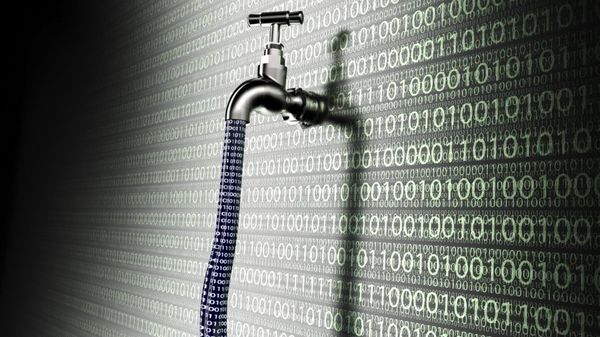
Black Mirror kicked off season 6 with a standout episode exploring computer-generated storytelling and the nightmare version of a social-media pile-on. 'Joan Is Awful' stars Annie Murphy as the titular character, an average, medium-awful woman whose life is turned into a prestige TV show on a streaming giant with hundreds of millions of subscribers. Also starring Salma Hayek as herself, the show includes several head-warping twists and several nods to current tech phenomenons that will have viewers firming up their privacy settings and taking a closer look the next time they're told to click "Accept" on an app's terms and conditions.
Read on for our breakdown of the episode's twists and turns, as well as its connections to real-life events in the entertainment industry.
'Joan Is Awful' is a show within a show within a show (and so on...)
The episode starts by showing Joan's (played by Annie Murphy) above-average life: loving fiancé, gorgeous house, leadership role at a tech company. The cracks in her life show up throughout her rough day, when she has to fire an employee (Ayo Edebiri) on behalf of the company's board. Then, after a therapy session where she admits that her fiancé Krish (Avi Nash) bores her a bit, she meets up with her ex Mac (Rob Delaney) who had been texting her all day, and ends up kissing him (though she does quickly regret it). The real Black Mirror plot starts when she gets home, and she and Krish pull up Streamberry to see a new show called 'Joan Is Awful,' starring Salma Hayek.
The Netflix stand-in (to the point where it has the same tu-dum sound effect) has somehow reproduced Joan's exact day, skewed to paint her in the most awful light. Salma-Joan is straight-up cruel while firing the employee, drops the e-cigarette on her head on purpose, and initiates the kiss with TV Mac (Ben Barnes). What's worse is that the invasion of privacy is public, so Joan's co-workers, neighbors, and friends can see it too. This ranges from her assistant Eric (Jared Goldstein) disliking his portrayal (shoutout to Jaboukie Young-White playing TV Eric), to Krish immediately breaking up with Joan after watching the therapy confession and the Mac kiss. The breakup also becomes part of the episode, as Salma-Joan and TV Krish (Himesh Patel) pull up an in-show version of 'Joan Is Awful' starring Cate Blanchett(!) as Joan.
The losses just keep piling on as 'Joan Is Awful' becomes a (slightly unrealistic) instant phenomenon. The very next day, neighbors that used to be friendly are shaming Joan, and her job fires her because the show included company information that was under an NDA. When Joan seeks legal counsel to sue Streamberry, her lawyer (Lolly Adefope, with TV lawyer played by Wunmi Mosaku) tells her that she can't do anything, as Joan "assigned them the right to exploit" her image and her entire life when she accepted the company's terms and conditions upon signing up for the service. (This is definitely the most terrifying part of the episode.) As for how Streamberry even knows all the details of her life, that's thanks to a system of hidden surveillance that also seems part and parcel to being a tech user. The lawyer compares it to cookies and the phenomenon where someone mentions an item or hobby out loud and then ads for the same thing show up in a banner ad or their Instagram feed. (Again, a low-key terrifying thing we've all gotten used to.)
When Joan throws out her next idea, suing Salma Hayek for portraying her, we learn that the Salma-Joan on 'Joan Is Awful' isn't actually played by the Oscar nominee. Instead, it's a "digital likeness," a.k.a. an A.I.-deepfake situation where Salma sold the licensing for her image to Streamberry for use in the show. Salma's contract also means that they can use her image for whatever they want, with the lawyer saying they could make her "blow an orangutan" if they want to, though the actress would likely object. That possibility of the actress objecting and shutting down the whole thing leads Joan to her next tactic, where she (lemme think of how to say this in a safe-for-work fashion...) takes a bunch of laxatives and defecates in the middle of a random couple's church wedding.
Salma is rightfully pissed that an image of her defecating in a church is now available on a widely-popular streaming platform. However, she's in just as tight a bind as Joan, since the Streamberry contract is ironclad (defecation is even specifically mentioned in the fine print). After Salma tells off her own lawyer in some choice language (seriously, if you haven't seen the ep for whatever reason, her performance is more than worth the watch), she heads over to Joan's place, where the two mortified women team up to stop the show by any means possible.

The real-life Joan destroys 'Joan Is Awful.'
Once they arrive at Streamberry's headquarters, the unlikely team make their way to the office of CEO Mona Javadi (Leila Farzad). They eavesdrop on Javadi's supervillain monologue, which is in the form of an interview where she lays out the grand plan for the streamer's computer-generated shows. Every one of Streamberry's 800 million subscribers will soon be getting their own '[Insert Name] is Awful' series. Joan was only chosen to be the test series because she's a "totally average, nobody person," at least in the middle-to-upper-class television standard. As for why the shows all depict their subjects as "Awful" rather than "Awesome," testing showed the negative skew would put viewers into a state of mesmerized horror and really drive engagement. (Seeing as there are some reality shows currently airing that bring this exact effect, I believe it.)
(Side note: This, besides being terrifying, also reminded me a bit of season 1 episode 'The Entire History of You;' if everyone will also be able to see everyone else's episodes, then they could hypothetically watch the same interaction or meeting interpreted in several different ways, like how the characters in the prior episode pulled up and analyzed recordings from the grains.)
Javadi's interview also includes a very convenient mention of the location of the quantum computer that will generate all of these shows. Joan and Salma break into the secured room, surprising a Streamberry employee played by Michael Cera (!), who's watching the computer generate a new episode of 'Joan Is Awful'...starring her. Meaning, the Annie-Joan we've been watching this whole time, who shouldn't be on the computer since she's the real-life source. That's when the whole episode becomes a high-tech onion: Annie-Joan is not the real Joan. She's the computer-generated image using actress Annie Murphy's likeness, and what we've seen this whole time is the show 'Joan Is Awful' being generated on what Cera calls Fictive Level One. None of the people we've met are real; they're all CGI characters made from actors likenesses (including real-life Michael Cera, who also sold his image to Netflix). The real Salma Hayek licensed her image to play Joan on Fictive Level Two, and herself on Fictive Level One. In fact, the episode foreshadowed this twist right at the start, as it first showed a Netflix-style 'Joan Is Awful' title card. We've never seen the real-life Joan, or Source Joan until she shows up on the quantum computer's screen.
So here lies an ethical dilemma. By taking an ax to the quantum computer, Fictive Level One Joan (a.k.a. Annie-Joan) will destroy all of the CG people who are "living" inside of these shows, meaning they will be "killing" the "billions of simulated souls who consider themselves to be real." Upon learning this, Fictive Level One Salma understandably wants to live, so she tells Annie-Joan to stop. However, the Joan we've been following all along realizes that every action she's done has happened because it was Source Joan who made those decisions. Source Joan has already decided to take control of her life by destroying the machine, so Annie-Joan is just fulfilling what's already been done. With that, Annie-Joan hacks up the computer, and we see everyone blink out to show Source Joan holding the ax and the real Annie Murphy next to her, wearing the yellow jumpsuit that Fictive Salma had been wearing.
The rest of the episode takes place in the real world. Source Joan has changed her life; she's working her dream job of running a coffee shop, while dating again and learning to be okay on her own. The real Annie even visits the shop, where we see them both wearing matching ankle monitors as part of whatever punishment they've gotten for destroying a machine that probably cost millions of dollars. When she's talking to her therapist again, Joan truly seems happy after rebuilding her new life. And after that happy ending, the after-credits scene ends the episode with the footage of Source Joan defecating in the church, because of course it does.
'Joan Is Awful' was partly inspired by 'The Dropout.'
In a Wired interview, Black Mirror creator Charlie Brooker opened up about getting inspiration for the new season's episodes while watching a bunch of television during the pandemic, including lots of true-crime programs. For 'Joan Is Awful,' Brooker brought up The Dropout, the scripted show based on the Theranos scandal where Amanda Seyfried played now-convicted scammer Elizabeth Holmes. Specifically, the creator was struck by how weird it must have been for the real-life people involved in the events being depicted. "You had all these celebrities playing people who must be sitting at home watching this," he told the outlet.
“One of the things I was thinking about [in creating ‘Joan’] was deepfakes and AI-generated imagery. I’d been toying with an idea about a news network that just pumps out deepfakes and calls it drama. I couldn’t work out what the actual story was, but it was a scary idea,” Brooker told the magazine. “And then when I watched [Hulu’s] The Dropout with my wife, we were like, ‘This feels like it happened 10 minutes ago! Imagine if Amanda Seyfried, while playing Elizabeth Holmes, switches on the TV and sees The Dropout.'”

'Joan Is Awful' connects to real-life concerns in the entertainment industry.
The release of this episode comes at a prescient time, in the middle of the Writers Guild of America strike and soon after a majority of Screen Actors Guild members voted in favor of a strike authorization. Both of these actions are partly in response to the possible use of AI tools like ChatGPT and the CGI likenesses we see in the episode, as well as concerns their use could lead to lower pay and less opportunities for writers and actors in the future. In a way, 'Joan Is Awful' is a perfect example of Black Mirror's tendency to predict societal changes; ahead of the season's release, Brooker told Variety that the whole episode was "written and wrapped" before ChatGPT even launched.
In another interesting detail, the map of Streamberry's research and development floor includes an "AI Prompt Writers Room," which sounds very similar to a concern Brooker mentioned in the Wired interview when asked his thoughts about AI.
"The worry at the moment is that executives will use it to generate a list of crap ideas that have been mulched together from actual humans’ unpaid ideas: hoovered up off the internet and then mushed together into a mash," he told the outlet. "Great, I own this IP, now I’ll hire in human writers cheaply to actually make this serviceable, because ChatGPT cannot do that at the moment. That’s certainly a valid concern."







